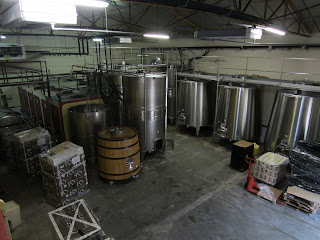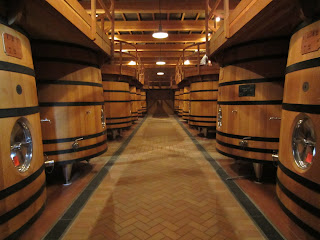I spent a nice weekend checking out some of the sights in Marseille and Avignon, two very important and historic cities in Provence, before heading to the next region on my trip. I was actually returning to another region I visited in France when I was here in 2010, but much like Alsace I could only spend one day in the Rhone Valley when I last visited. Whilst this was long enough to fall in love with the region, it wasn't enough to truly learn about the different appelations and wine styles, so I was very excited to return. My plan was to spend a few days in the Southern Rhone, and a few more in the Northern Rhone, because the Valley is a few hundred kilometres long which I discovered in 2010 when I drove from Lyon to Chateauneuf-du-Pape and back in one day. From north to south they are completely different in many ways, and therefore should never be considered as one region, much like Provence. Whilst all the varieties that are grown in the Northern Rhone are found in the Southern Rhone, the opposite is not true, and the wines are very different. The appellation of Chateauneuf-du-Pape itself, covering 3,000 hectares of vineyards making it one of the largest single appelations in France, can use up to 13 varieties. Whilst the Northern Rhone has very steep vineyards with very different terroirs and only four varieties, the Southern Rhone has generally flatter vineyards and more varieties to work with and blend.
 |
| One of the most iconic items in French wine |
The first appointment in the Rhone Valley was with a producer based in the historic village of Chateauneuf-du-Pape, but makes wine from fruit grown in several parts of the Southern Rhone Valley. Cave Roger Sabon was established back in 1952, one of three sons of Seraphin Sabon and Marie Jausset, who continued the family tradition of wine production but with his own business. The original estates in Chateauneuf have grown over the years to now total 15 hectares, but as his sons joined the business they purchased new vineyards in Lirac and the Cotes-du-Rhone AOC. White and red wines are made with passion and integrity, and exported all over the world. The chief winemaker Didier Negron took me through the winery to show how he crafts each of the terroirs into wine. The wines are fermented in a mixture of stainless steel tanks and cement vats depending on the variety and style, and similarly maturation choices are made based on these factors as well. The Chateuneuf terroir is expressed through one white wine, and three red wines of different quality levels. The Secret de Sabon is the top of the pile, and is only released in exceptional vintages. Click
here to read my notes from the tasting.
 |
| Cave Roger Sabon winery |
One of the oldest estates in the Cheateauneuf appellation is one of the most famous and important, as they helped establish the region as the best in France. Back in the 19th Century when wines from this area were three times more expensive than their neighbours, and at the top of this list was Chateau La Nerthe which was considered a first class wine. In attempting to learn why their wines were considered as superior, the current owners discovered that the winemaking techniques employed in this era are very similar to how they make the wine today, albeit with less understanding of the science of the wines to observe and control them. The original owners of the estate, the Tulle de Villefrance family, sold it after the ravages of phylloxera throughout Europe in the late 19th Century. The next steward of the estate was Commander Joseph Ducos, who decided to buck the trends and continue to plant grapes for the production of wine. He used his background in engineering and agronomy to design a new system of grafting vines onto root-stocks that were resistant to the deadly disease, a practice that is common all over the world now. This is how Chateau La Nerthe was able to re-establish its reputation long before many other producers in France at such a difficult, many of whom didn’t recover until after the First World War, and others until after the Second.
 |
| The famous cellars of Chateau La Nerthe |
Ducos also performed research on the different varieties grown in the area, and identified the best blend based on the characteristics of each variety. Apparently he also introduced three of the 13 varieties into the area, and additionally decided to vinify all the varieties separately and blend them afterwards. The estate fell into the hands of the Nazis in World War Two, and wasn't taken care of for forty years after the war until it was purchased by the current owners the Richard family. The La Nerthe vineyards cover an area of over 100 hectares, making La Nerthe one of the largest in an appellation which covers 3,000 hectares in total. The Director of the estate since 2007 has been Christian Voeux, who previously managed Chateau Montredon, the largest estate in the region. Christian took me through the estate vineyards and explained the different practices used on the estate to get the most out of the terroir and the varieties. We then headed up to the plateau of Le Crau, generally considered to be the best terroir in the area. These vineyards have the famous large and smooth alluvial stones sitting on the topsoil, which are so important for heat retention, reflection of sunlight into the canopy, and moderation of temperature and humidity, all helping the ripening of the fruit.
 |
| Classic CT9 vineyards in the Le Crau |
La Nerthe is certified organic and also uses bio-dynamic principles were they feel it is beneficial. Organic viticulture is ideal for the region, not to mention quite easy, as there are rarely problems with fungal diseases or water, and there are adequate nutrients and minerals in the soil to keep the vines relatively healthy. If anything organic viticulture is preferable for the region as it tends to reduce yields and preserve quality, as well as concentrating the berries more and in my opinion better expressing the terroir. The winery is designed to very simply extract the essence of the terroir, gently macerating and maturing the wines to keep them velvety and generous. One of the biggest draw-cards in the winery is the historic cellar, the most impressive in the Rhone Valley. Click
here to read my tasting notes.
 |
| Fresh rain providing some much needed refreshment to the vines |
Domaine Beaucastel is an estate that has been instrumental in re-establishing Chateauneuf-du-Pape to the acclaim it once had. The winery is famous for being one of the last in the area to use all 13 allowed varieties (including four white) in their red wine. The estate straddles the northern border of the appellation, with vineyards within the limits of Chateauneuf-du-Pape and some in the Cotes-du-Rhone area. Geologically the soil is very old and deep, but above ground it is very flat and dry, ideal for the ripening of the indigenous varieties. The vineyards are managed using bio-dynamic principles, and they feel that the vines are stronger and produce better fruit without irrigation or chemicals in the vineyard. It is owned by the Perrin family, who are very important in the Rhone Valley for wine production and distribution to the world.
 |
| Entrance to the Beaucastel vineyards |
Most of the winery has been recently renovated to handle the many varieties and parcels of fruit. Fruit is very carefully sorted once it arrives in the winery so that only healthy and perfectly ripe berries are processed. Red wines are mostly fermented and macerated in large oak vats, with a combination of pump-overs and plunging to gently extract the tannins and colour. A variety of sizes and ages of barrels are used to mature the wines, to add complexity and depth. Wines are left in bottle for many months after bottling to allow the wine to settle and become more drinkable on release. Like the majority of growers in the region they are using small tags in the vineyards that send out a hormone to sexually confuse any insects considered as pests that would influence the vines and fruit. The wines they produce are very sought after, and customers wait for the release each year with impatience and anticipation. Click
here to read my tasting notes.
 |
| Fermentation casks at Domaine Beaucastel |
The final estate I visited for a very quick tasting was Clos de Papes, an absolute institution and a cult winery in the region. Paul Eugene Avril was one of the most important contributors to the establishment of Chateauneuf-du-Pape as the first Appelation Controlee (AOC) in France, but the brand has existed since 1896. Today 70% of their production is exported, and of the 30% sold in France, 70% is direct to private customers. As the staff member working in the tasting room didn’t speak any English, I wasn't able to ask any specific questions about the vineyards or winemaking, but I was able to taste. Click
here to read my tasting notes.
 |
| Clos des Papes |
Click
here to see more photos from Day One in the Rhone Valley, France. In my next post, I visit negociant producer Tardieu-Laurent, and icon Chateauneuf-du-Pape producer Vieux Telegraphe.








No comments:
Post a Comment